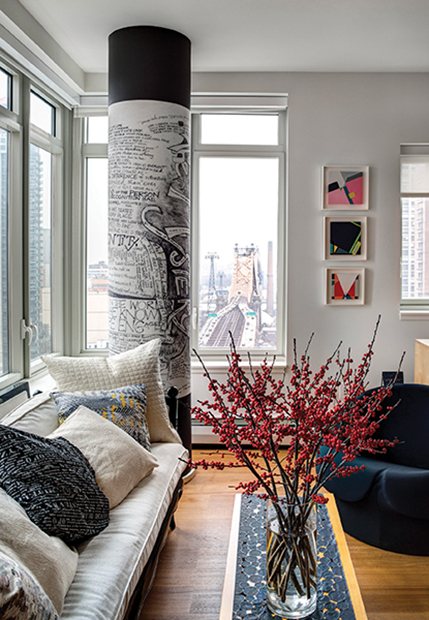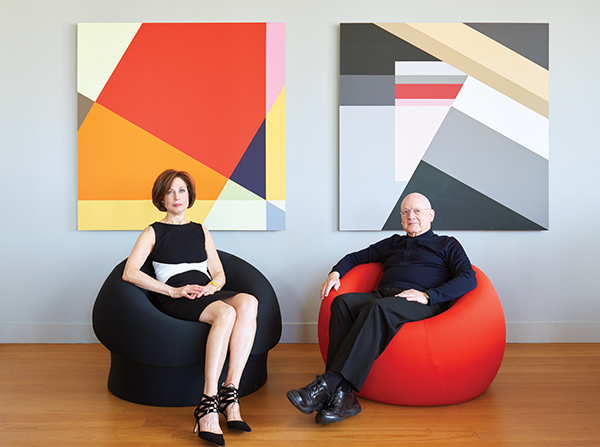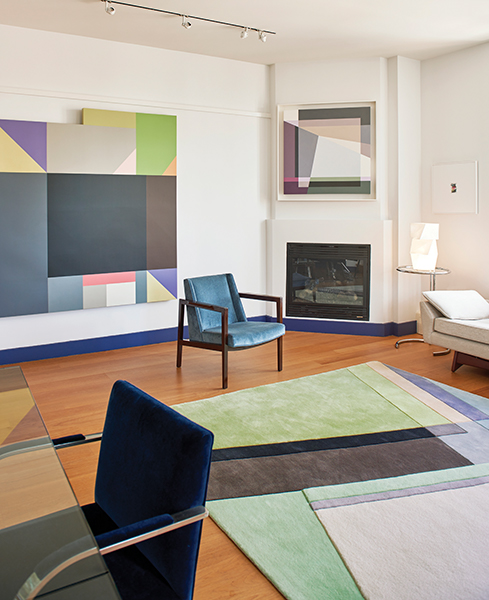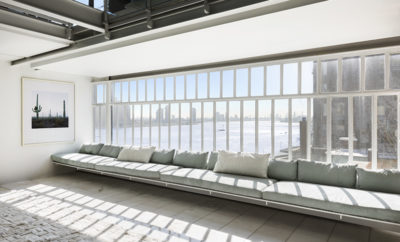
Design
Shape-shifting
IN NEW DESIGN EXPERIMENTS, painter Judith Seligson is translating her aesthetic ideas into reproducible quotidian objects. Since the mid-1970s, Seligson has created hard-edged geometric abstractions that delicately and precisely play with color and space. In her paintings, shapes emerge, recede, and interact according to their meticulously selected hues. She’s described the shapes in her panels and canvases as “visual melodies,” likening their individual forms to musical notes. Recently, Seligson began commissioning rugs that transfer her unique vision from wall to floor.

Overlooking the Queensboro Bridge, the living area in Judith Seligson and Allan Greenberg’s apartment features a structural column wrapped with
a reproduction of a drawing from Seligson’s Visual Intertextuality series, and several of her paintings, including Aim to Please, Port,
and Sets, which hang between the windows, above a Gaetano Pesce UP2 armchair. BRUCE BUCK PHOTO FOR THE NEW YORK TIMES.
Seligson made her first rug in 1980 in India, a “dhurrie” style, known for its thick, flat weave, often with graphic patterns, typical of the region. While she remained interested in the form, she lacked opportunities for production. This past March, she exhibited her paintings at Manhattan’s Architectural Digest Design Show, and there connected with Barbara Barran, owner of the city’s Classic Rug Collection Inc. “When you collaborate with somebody, you really are relying on their expertise,” Seligson says. “And I feel I lucked out.” Together, the pair determined how to best translate Seligson’s brushstrokes into wool and silk, carefully choosing a representative palette. They decided to hand carve grooves into the material to approximate the texture of Seligson’s paintings. She doesn’t mind that people will literally walk all over her new work—“that’s part of the fun of it. It’s useful,” she says.

Seligson in Pesce’s Black UP3 armchair and Allan Greenberg, in the UP2 armchair, sit in front of digital prints of Seligson’s paintings Candy and Interference.
Four finished rugs now lie in Seligson’s East 59th Street apartment, which she shares with her husband, architect Allan Greenberg (they divide their time between Manhattan and Alexandria, Virginia). “This has always been an exhibition space,” she says of the light-filled, wood-floored living area, which overlooks the Queensboro Bridge. Greenberg designed the scallop-edged kitchen counter and a cylindrical bookshelf, which infuse the space with a playful contrast to the sleek edges in Seligson’s paintings on the walls. The pair recently redecorated, purchasing furniture by some of the most prominent designers of the past century. First, they bought six blue velvet Brno chairs (which provided seating at the famed Four Seasons restaurant) by architect Ludwig Mies van der Rohe. “You had me at blue velvet,” Seligson says. She fit four of them around a Norman Foster table with a rectangular glass top and metal legs that bend at the bottom and end in sturdy, shiny discs. A long, elegant, o -white sofa by the iconic American designer of the 1950s and ‘60s, Adrian Pearsall, faces the kitchen.

A custom multilevel rug made in collaboration with Barbara Barran of Classic Rug Collection and based on Seligson’s painting Decisive lies in front of a lounge chair by Edward Wormley for Dunbar. To the left, a Ludwig Mies van der Rohe Brno chair sits at a glass-topped Nomos table by Norman Foster, and to the right, a white Adrian Pearsall sofa is accented by an Eileen Gray adjustable table with Issey Miyake’s Mogura table lamp atop. Seligson’s Somewhere to Hide, Self-portrait, and Radical IF hang on the wall, from left to right.
Seligson hired a painter to interpret more of her own work onto the four kitchen cabinet panels behind the counter. “They’re conceptual pieces in the sense that I gave them a set of instructions, you know, à la Sol LeWitt,” she explains, invoking the conceptual artist who famously left directions for future generations to recreate his oeuvre.
Next up for Seligson: yet another translation, this time into printed matter. Her forthcoming book, Gap Anxiety, is a synthesis of the ways in which gaps operate in literature, art, and neuroscience, encouraging readers to rethink ideas of incompletion and absence. She also hopes to make more rugs and commissioned installations that will render her paintings onto walls and doors. A new gallery—AH Contemporary—that her daughter, writer Hannah Seligson, is opening with her husband, consultant Andrew Eil, will represent her. Seligson will continue to explore and experiment creatively; it’ll be up to the couple to convert it all into a business.










